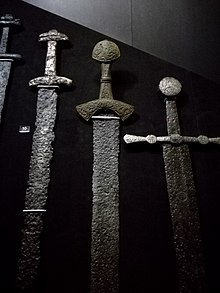The Suontaka sword (Finnish: Suontaan miekka) was found in what was previously interpreted as a high-status woman's grave at Suontaka Vesitorninmäki, Tyrväntö, Finland in 1968.[1] Based on a study published in 2021, the sword was likely hidden in the grave some time after the burial.[2] The grave dates from the late Nordic Iron Age, c. 1040–1174 AD, and it also included another hiltless sword with silver-inlays that was placed directly on the buried corpse. Ancient DNA analysis found that the individual likely had Klinefelter syndrome, indicated through the presence of XXY chromosomes.[2] The individual had been buried in a female dress with three brooches.[citation needed]

The bronze-hilted sword was made with grip and hilt entirely in hollow cast bronze.[3] The sword blade contains texts +NMIN+ and +NIOIN+, which can be abbreviations of In nomine Domini (Latin for "In the name of the Lord")[4] or variations of the text "in the name of god".[3][verification needed] The sword is considered to be a unique work of art for its time.[citation needed]
Suontaka village is in Häme, Finland. This area of Häme is known for its numerous sword-findings and archaeological sites.[5] The time during which the sword was in use was a prosperous yet violent time in the Häme region. The original sword is in display in the National Museum of Finland.[citation needed] Interpretations have suggested the burial is evidence of gender fluidity in the past.[6]
References edit
- ^ Henley, Jon (9 August 2021). "1,000-year-old remains in Finland may be non-binary iron age leader". The Guardian. London. Retrieved 9 August 2021.
- ^ a b Moilanen, Ulla; Kirkinen, Tuija; Saari, Nelli-Johanna; Rohrlach, Adam B.; Krause, Johannes; Onkamo, Päivi; Salmela, Elina (2021-07-15). "A Woman with a Sword? – Weapon Grave at Suontaka Vesitorninmäki, Finland". European Journal of Archaeology. 25. Cambridge University Press: 42–60. doi:10.1017/eaa.2021.30. hdl:10138/340641. ISSN 1461-9571.
- ^ a b Moilanen, Mikko (2018). Viikinkimiekat Suomessa. Suomalaisen kirjallisuuden seura. p. 185. ISBN 9789522229649.
- ^ Moilanen, Mikko (2016-02-06). Marks of Fire, Value and Faith. Swords with Ferrous Inlays in Finland during the Late Iron Age (ca. 700–1200 AD). Society for Medieval Archaeology in Finland. p. 147. ISBN 978-952-67329-6-1.
- ^ "Kulttuuriympäristön palveluikkuna". www.kyppi.fi. Retrieved 2021-07-18.
- ^ Moilanen, Ulla; Kirkinen, Tuija; Saari, Nelli-Johanna; Rohrlach, Adam B.; Krause, Johannes; Onkamo, Päivi; Salmela, Elina (2022). "A Woman with a Sword? – Weapon Grave at Suontaka Vesitorninmäki, Finland". European Journal of Archaeology. 25 (1): 42–60. doi:10.1017/eaa.2021.30. ISSN 1461-9571.
External links edit
- Sword Found in a Woman's Grave in Suontaka Finland, Sword-Site
- KM17777:1 at the Finnish Heritage Agency